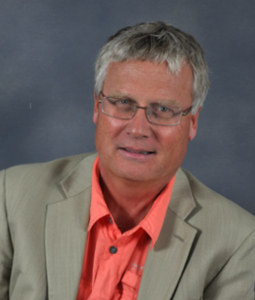Department of Chemistry and Biochemistry
Faculty and Staff Directory
Thomas Vogt
| Title: | Educational Foundation Distinguished Professor of Chemistry and Biochemistry / Inorganic Catalysis / Chemical Physics / Crystallography / Environmental / Materials / Nano / Physical and Theoretical / Solid State |
| Department: | Chemistry and Biochemistry McCausland College of Arts and Sciences |
| Email: | tvogt@mailbox.sc.edu |
| Phone: | 803-777-1151 |
| Fax: | 803-777-9521 |
| Office: | Office: GSRC 307 Lab: GSRC 529, 803-777-4769 |
| Resources: | CV [pdf] All Publications Department of Chemistry and Biochemistry |

Education
Diploma, 1985, University of Tübingen
Ph.D., 1987, University of Tübingen
Honors and Awards
- Educational Foundation Award in Science, Mathematics and Engineering, 2019
- Carolina Trustee Professorship at the University of South Carolina, 2018
- Fellow of the Neutron Scattering Society of America, 2018
- Fellowship at the Institute of Advanced Study, Duham University, UK, 2018
- Fellow of the American Association for the Advancement of Science, 2008
- Fellow of the American Physical Society, 2006
- Director of NanoCenter at the University of South Carolina, 2005
Research Interests
Research Areas: Crystallography; General structural chemistry; Chemical synthesis, structures and properties of metal oxides; electron, x-ray and neutron diffraction techniques and instrumentation (i.e high pressure x-ray diffraction, high temperature electron microscopy)
Research Project 1: Pressure-Induced Hydration and Insertion of CO2, noble gases and rare earth metal cations. Supported by a Global research Laboratory of the Korean Ministry of Education, Science and Technology we have been studying the Insertion of water, CO2, rare earth metal cations and noble gases in the small pore zeolite natrolite.
Research Project 2: New Phosphors for Up- and Down- Conversion of Light. Luminescenece, the absorption of energy with subsequent emission of light and more specific, fluorescence, the absorption of energy with subsequent emission of light in the visible spectrum are the basis of a broad range of every day applications such as lighting and x-ray detectors for medical and technical applications. Luminescent materials, also called phosphors, consist of a host lattice in which activator ions are doped into in small concentrations, typically less than a mole percent. The activator ions have energy levels that can be populated by direct excitation or indirectly by energy transfer, and are responsible for the luminescence. We have discovered a new family of luminescent materials and are currently exploring its use in white light LED applications as well as upconversion applications such as biomedical imaging. This work involves solid state synthesis, structural characterization using x-ray powder diffraction and extensive characterization of the optical properties.
Research Project 3: Imaging at the Nanoscale High-Angle-Annular-Dark-Field/Scanning Transmission Electron Microscopy (HAADF/STEM) is a technique uniquely suited for detailed studies of the structure and composition of complex oxides. The HAADF detector collects electrons which interact inelastically with the potentials of the atoms in the specimen and therefore resembles the better known Z2 (Z is atomic number) Rutherford scattering. One class of important catalysts consists of bronzes based on pentagonal {Mo6O21} building units; these include Mo5O14 and Mo17O47. In the last 20 years, new materials doped with a variety of substitution elements, but built upon the same structural building units, have been made and evaluated for their catalytic properties. Applications include the selective oxidation of light paraffins and olefins, as well as the partial oxidation of methanol. We engage in HAADF-STEM investigations of various complex oxide phases and have shown that we can for example distinguish metal-containing sites within these structurally and compositionally complex-oxides through Z2-contrast analysis. We compare our experiments to image simulations which are done in collaboration with the Interdisciplinary Mathematics Institute here at USC. Collaboration with Douglas Blom (University of South Carolina) and Douglas Buttrey (University of Delaware).
Selected Publications
Hwang, Huijeong; Seoung, Donghoon; Lee, Yongjae; Liu, Zhenxian; Liermann, Hanns-Peter; Cynn, Hyunchae; Vogt, Thomas; Kao, Chi-Chang; Mao, Ho-Kwang. "A Role for Subducted Super-Hydrated Kaolinite in Earth’s Deep Water Cycle." Nature Geoscience, 2017, 10, 947-953. DOI: 10.1038/s41561-017-0008-1.
Tate, Matthew L.; Blom, Douglas A.; Avdeev, Maxim; Brand, Helen EA; McIntyre, Garry
J.; Vogt, Thomas; Evans, Ivana Radosavljevic. "New Apatite‐Type Oxide Ion Conductor,
Bi2La8[(GeO4)6]O3: Structure, Properties, and Direct Imaging of Low‐Level Interstitial Oxygen Atoms
Using Aberration‐Corrected Scanning Transmission Electron Microscopy." Adv. Funct. Materials, 2017, 27(8) 1605625.
DOI: 10.1002/adfm.201605625.
Seoung, Donghoon; Lee, Yongmoon; Cynn, Hyunchae; Park, Changyong; Choi, Kwang-Yong;
Blom, Douglas A.; Evans, William J.; Kao, Chi-Chang; Vogt, Thomas; Lee, Yongjae. "Irreversible
Xenon Insertion into a Small Pore Zeolite at Moderate Pressure and Temperatures." Nature Chemistry 2014, 6(9), 835-839.
DOI: 10.1038/nchem.1997.
Vogt, Thomas; Blom, Douglas A.; Jones, Lewys; Buttrey, Douglas J. "ADF-STEM Imaging of Nascent Phases and Extended Disorder Within the Mo–V–Nb–Te–O Catalyst System." Topics in Catalysis, 2016, Volume 59, Issue 17–18, pp 1489–1495. DOI:10.1007/s11244-016-0665-0.
Im, Junhyuck; Seoung, Donghoon; Lee, Seung Yeop; Blom, Douglas A.; Vogt, Thomas; Kao, Chi-Chang; Lee, Yongjae. "Pressure-Induced Metathesis Reaction to sequester Cs." Environmental Science & Technology, 2014, 49(1), 513-519. DOI:10.1021/es504659z.